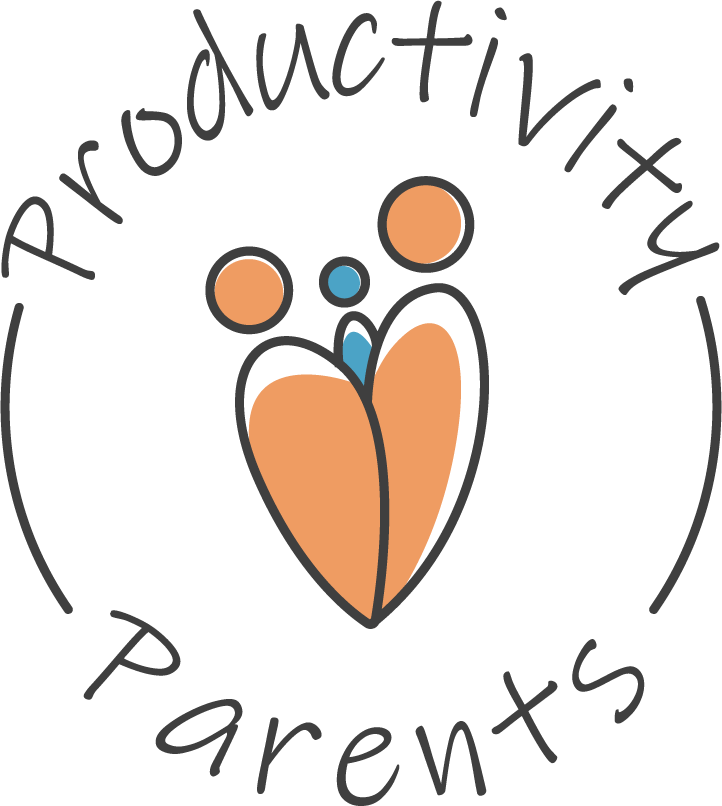Managing your child’s allowance and chores doesn’t have to involve paper charts and coin jars anymore. Today’s digital tools offer parents streamlined ways to track responsibilities and financial lessons all in one place. Using chore and allowance apps for families can transform how children learn about money management while making the process more engaging for everyone involved.
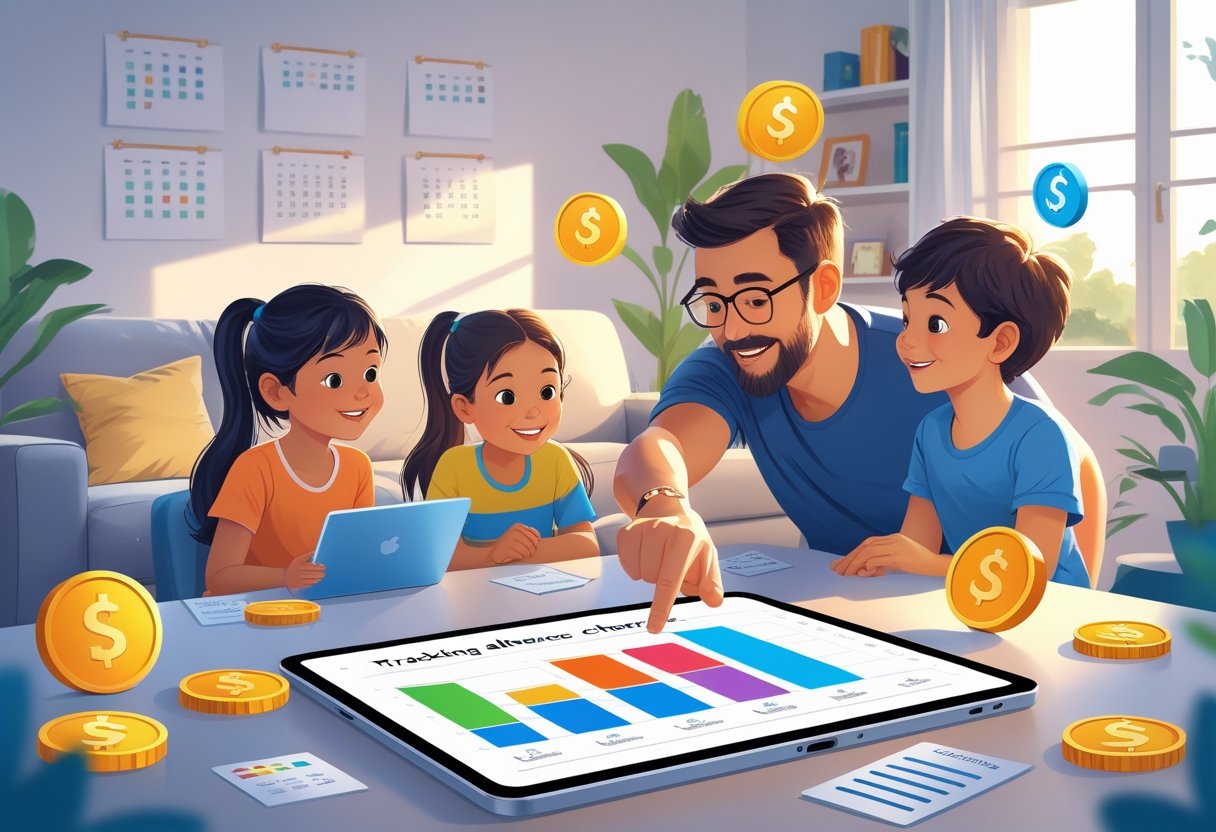
I’ve found that digital platforms like GoHenry and S’moresUp offer far more than just chore tracking—they provide comprehensive financial education tools that grow with your child. These apps allow me to assign tasks, automate allowance payments, and monitor my kids’ spending habits all from my smartphone, creating teachable moments about earning, saving, and responsible spending.
Key Takeaways
- Digital allowance and chore tracking tools simplify household management while teaching children valuable money skills through interactive features.
- Most family finance apps offer customizable chore assignments, automated payments, and parental controls to adapt to your family’s unique needs.
- Setting up a digital allowance system creates natural opportunities for ongoing conversations about financial responsibility and independence.
Benefits of Tracking Kids’ Allowances and Chores Digitally
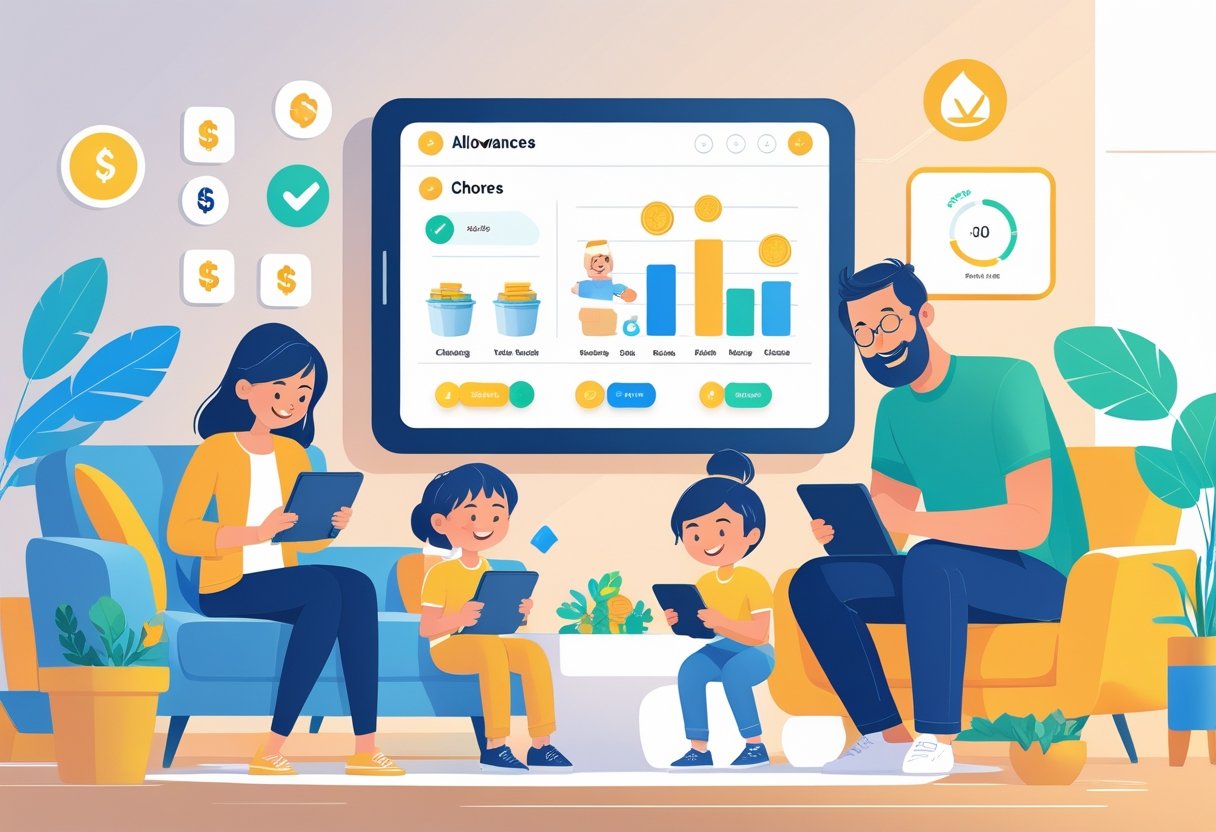
Digital tools have revolutionized how families manage allowances and chore systems, offering significant advantages over traditional cash-based methods. These technologies provide real-time visibility, automation capabilities, and interactive features that benefit both parents and children.
Developing Financial Responsibility
Digital tracking tools help children visualize their money growth in ways that cash can’t match. When kids can see their savings accumulate in real-time, they develop stronger connections between their actions and financial outcomes.
I’ve found that digital platforms often include educational features that teach fundamental concepts like saving, spending, and donating categories. These visual representations help children understand percentages and allocation in practical ways.
Many apps include goal-setting features where kids can create savings targets for desired items. This teaches delayed gratification and planning skills that are essential for adult financial success.
Digital tools also provide a safe environment for children to make mistakes and learn from them, as parents can monitor decisions without micromanaging every choice.
Encouraging Consistent Habits
Automated allowance systems eliminate the common problem of parents forgetting to have cash on hand for allowance day. This consistency reinforces the connection between completed responsibilities and earned rewards.
Digital platforms typically include chore tracking features with:
- Visual checklists or calendars
- Completion verification systems
- Reward calculation automation
- Streak or achievement badges
These gamification elements tap into children’s natural motivation systems. I’ve noticed that kids are more likely to maintain consistent habits when they can track their “winning streaks” or earn special recognition.
The accountability provided by digital tracking reduces disagreements about whether chores were actually completed. Everything is logged in the system, creating clear expectations and outcomes.
Fostering Parent-Child Communication
Digital allowance tools create natural opportunities for meaningful financial discussions. When reviewing app data together, parents can point out spending patterns or celebrate savings milestones in concrete ways.
Including children in family money conversations through these platforms nurtures their financial independence. I’ve seen how these tools facilitate age-appropriate discussions about budgeting, interest, and responsible financial decision-making.
Many parents appreciate how digital platforms reduce awkward money conversations. Instead of direct criticism, the app data speaks for itself, making feedback feel less personal and more objective.
Digital tools also allow for flexibility in parental oversight based on a child’s age and maturity. Parents can gradually reduce monitoring as children demonstrate responsible habits, creating a pathway to financial independence.
Key Features of Digital Allowance and Chore Tracking Tools

Modern chore and allowance apps combine financial education with responsibility training through several essential features. These digital tools have revolutionized how families manage household tasks while teaching children valuable money management skills.
Automated Allowance Distribution
Digital tracking tools offer seamless automated allowance distribution based on completed chores. I’ve found that parents can set up recurring transfers that automatically deposit funds into children’s accounts when tasks are verified as complete.
Many apps allow linking to real bank accounts or virtual wallets, eliminating the need for cash transactions. This automation teaches children about regular income while reducing parents’ mental load of remembering payment schedules.
The best tools provide flexibility in payment timing, allowing for weekly, bi-weekly, or monthly distributions to match family preferences. Some apps even offer the ability to split allowances between spending, saving, and charitable giving accounts, reinforcing healthy money habits early.
Parents can adjust payment amounts based on task difficulty or child’s age, creating fair compensation systems across siblings of different ages.
Customizable Chore Schedules
The ability to create personalized chore lists makes these tools highly adaptable to different family situations. Parents can assign specific tasks to individual children based on their ages and abilities.
Most apps include options for one-time tasks and recurring chores with adjustable frequencies. This helps establish clear expectations and routines.
I’ve seen that effective tools allow for age-appropriate task assignments with detailed instructions or photos for younger children. This promotes independence as kids can check requirements without asking parents repeatedly.
Many platforms include the ability to rotate chores between family members to ensure everyone learns different skills. Some more advanced apps even factor in school schedules, extracurricular activities, or seasonal tasks when generating recommended chore plans.
Task deadlines and reminders help children develop time management skills alongside responsibility.
Reward and Incentive Systems
Beyond monetary rewards, digital tools often incorporate engaging incentive systems that boost motivation. Children can earn badges, points, or virtual trophies for completing tasks consistently.
Many apps gamify the chore experience with level-up systems, achievement unlocks, or character customization as additional rewards. This makes routine tasks more engaging for tech-savvy kids.
I’ve observed that effective platforms allow parents to establish bonus rewards for streak completion or taking on extra responsibilities. This encourages consistent performance and initiative.
Some advanced tools incorporate savings goal visualizations where children can track progress toward desired items. This connects daily responsibilities with longer-term financial planning.
The best apps balance intrinsic and extrinsic motivation, gradually helping children transition from external rewards to personal satisfaction in responsibility.
Progress Monitoring and Reporting
Comprehensive tracking features provide valuable insights into children’s responsibility development and financial habits. Parents can monitor which chores are consistently completed and which may need adjustments or additional support.
Most platforms generate activity reports showing completed versus missed tasks over time. This data helps families have constructive conversations about patterns and improvements.
Financial tracking tools show allowance history, spending patterns, and saving progress. These reports help children visualize how small consistent actions accumulate into meaningful results.
I find that the best apps include parental notification systems that alert adults when tasks are marked complete for verification. Some advanced platforms offer analytical tools that identify behavioral patterns or suggest appropriate chore adjustments as children develop.
Many apps now include progress-sharing capabilities so extended family members can view and celebrate children’s accomplishments.
Popular Apps and Platforms for Families
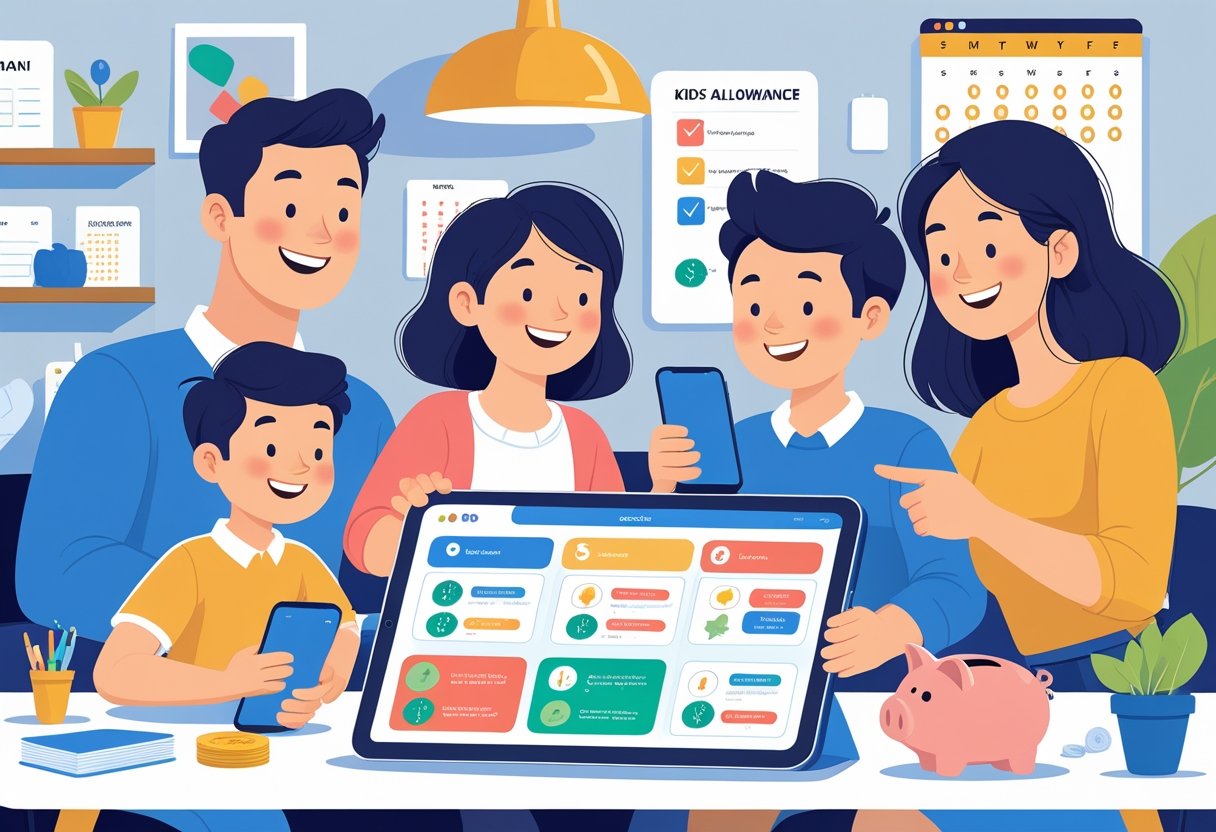
Managing kids’ allowances and chores has become much easier with digital tools that help track responsibilities and financial learning. These apps offer various features to accommodate different family needs, from basic chore tracking to more comprehensive financial education platforms.
Overview of Leading Apps
BusyKid stands out as a comprehensive solution combining task tracking with allowance management. It offers a prepaid debit card with parent controls, making it ideal for families wanting to teach financial responsibility.
Greenlight provides real-time spending notifications, allowing parents to stay informed about their children’s spending habits. This feature helps in monitoring financial activities while teaching children about budgeting.
Chores & Allowance Bot is praised for its simple yet effective interface. I find it particularly useful for families looking for straightforward chore tracking without overwhelming features.
Google’s Family Link offers excellent screen time management alongside other parental controls, making it a good option for families concerned about device usage.
Platform Compatibility
Most top allowance apps work across multiple devices, ensuring flexibility for various family setups. I’ve found that cross-platform functionality is essential for modern families where parents and children may use different types of devices.
Device Compatibility Table:
| App | iOS | Android | Web Version |
|---|---|---|---|
| BusyKid | ✓ | ✓ | ✓ |
| Greenlight | ✓ | ✓ | ✓ |
| Chores & Allowance Bot | ✓ | ✓ | Limited |
| Family Link | Limited | ✓ | ✓ |
Some apps offer web interfaces for parents while providing mobile access for children. This dual approach allows parents to set up and monitor activities from a computer while kids can check their responsibilities on their mobile devices.
User Experience for Parents and Kids
The best chore and allowance apps are designed with both parents and children in mind. Intuitive interfaces make it easy for kids to understand their responsibilities and track their earnings.
For parents, I recommend looking for apps with robust notification systems. These keep you informed about completed chores without constant checking.
Children benefit from visual elements like progress bars, achievement badges, and virtual rewards. These gamification features make responsibility tracking engaging rather than feeling like another chore.
Most effective apps allow customization to match your family’s specific needs and values. I’ve noticed that the ability to adjust chore difficulty, allowance amounts, and saving requirements helps families tailor the experience to their parenting approach.
Setting Up Digital Chore and Allowance Systems

Modern apps make it easy to create structured allowance systems that connect chores with rewards. These digital tools simplify the process of tracking responsibilities and managing money transfers while teaching children valuable financial lessons.
Initial Configuration and Onboarding
To begin setting up a digital chore system, I recommend downloading one of the popular allowance apps and creating separate profiles for each family member. Most platforms require basic information like names, ages, and sometimes profile pictures to personalize the experience.
The initial setup typically involves:
- Creating parent administrator accounts
- Adding children’s profiles with appropriate age settings
- Connecting payment methods (bank accounts or digital wallets)
- Setting weekly allowance amounts or chore payment rates
Many apps feature guided tutorials to help navigate the interface. I’ve found it helpful to involve children in this setup process, especially older kids who can learn about financial responsibility from the beginning.
The onboarding experience is designed to be straightforward, usually taking less than 20 minutes to complete. Most platforms offer free trials so you can test their functionality before committing.
Customizing Tasks and Rewards
The next step involves creating personalized chore lists tailored to each child’s age and abilities. Digital chore charts allow for detailed customization including:
Task Configuration Options:
- Difficulty levels and appropriate age ranges
- Frequency settings (daily, weekly, monthly)
- Point values or monetary rewards per task
- Photo verification requirements
- Deadline enforcement
I can establish whether allowances are tied directly to chore completion or operate as separate systems. Some families prefer automated allowance transfers based on successful task completion, while others maintain fixed weekly payments.
The most effective approach is creating a balanced mix of required responsibilities and bonus opportunities for earning extra. This teaches both baseline expectations and entrepreneurial thinking.
Integrating Family Schedules
Coordinating multiple children’s responsibilities becomes manageable with calendar integration features. I can sync the family’s existing digital calendars with chore app schedules to avoid conflicts with extracurricular activities or family commitments.
Modern allowance platforms offer notification systems that:
- Send reminders before chores are due
- Alert parents when tasks need verification
- Notify children when allowance transfers complete
- Provide weekly summary reports of completed tasks
For families with multiple children, I find rotation systems particularly effective. Digital tools can automatically rotate recurring chores between siblings on a weekly basis, ensuring fairness.
Some apps include gamification elements that transform chore completion into friendly competition. Leaderboards and achievement badges can motivate children while keeping the overall system integrated with real-world family schedules.
Parental Controls and Security Considerations
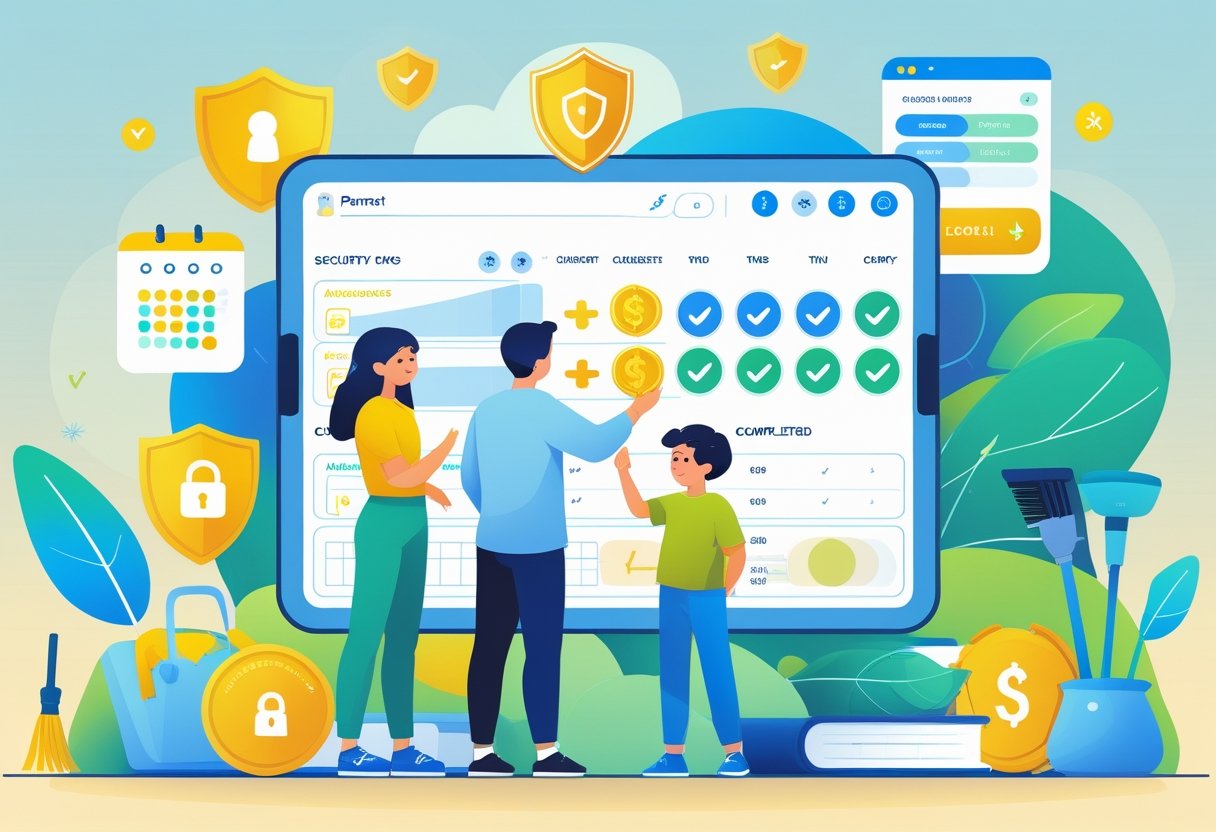
When implementing digital tools for tracking allowances and chores, safety and security must be prioritized. Modern family finance apps offer various levels of protection to ensure children’s data remains secure while parents maintain appropriate oversight.
Privacy Features
I’ve found that strong privacy features are essential in any child-focused financial app. Most reputable parental control solutions encrypt data transfers and storage to prevent unauthorized access.
Many apps now offer granular privacy settings that allow parents to control what information is shared outside the family unit. I recommend checking if the app has received any privacy certifications or complies with children’s online privacy regulations.
Look for apps that don’t sell data to third parties and have clear privacy policies written in plain language. The best apps minimize data collection to only what’s necessary for the service to function.
Remember that some apps might require different privacy settings for different age groups. Teenagers might need different privacy considerations than younger children.
Setting Permissions for Children
When setting up allowance and chore apps, I always customize permissions based on my child’s age and maturity level. Most quality apps offer tiered access controls.
For younger children, I restrict the ability to make transactions without approval. As they demonstrate responsibility, I gradually increase their autonomy.
Common permission settings include:
- Spending limits
- Approval requirements for purchases
- Access to specific features (savings goals vs. investment options)
- Communication permissions within the app
These parental control tools function as “training wheels” that help children learn financial responsibility in a protected environment. I adjust these permissions over time as my child develops better judgment and financial literacy skills.
Monitoring and Notifications
I rely heavily on notification features to stay informed about my children’s financial activities without hovering. Most chore tracker apps send real-time alerts for completed tasks, allowance deposits, and spending.
Custom notification settings allow me to choose which activities trigger alerts. I typically set alerts for:
- Large transactions
- Completed chores
- Missed deadlines
- Goal achievements
- Low account balances
These monitoring features strike a balance between supervision and independence. They provide teachable moments when I notice concerning patterns in spending or saving.
Many apps include weekly summary reports that track progress toward financial goals. These insights help me have meaningful conversations with my children about money management without micromanaging their day-to-day decisions.
Teaching Kids Financial Literacy With Digital Tools
Digital platforms provide powerful ways to instill financial wisdom in children. Modern apps combine engagement with education, making money management accessible and fun for young learners.
Introducing Budgeting Concepts
I’ve found that digital tools excel at introducing children to budgeting fundamentals through visual representations. Apps like GoHenry offer comprehensive financial literacy games that teach money concepts in an interactive format. These games transform abstract financial ideas into tangible experiences kids can understand.
When introducing budgeting, I recommend starting with the three-jar system (spend, save, give) which many apps digitally replicate. This creates a foundation for responsible money management.
Several platforms include:
- Interactive budgeting templates customized for children’s needs
- Visual progress trackers showing savings growth
- Digital “envelopes” for different spending categories
These features help children understand the relationship between income, expenses, and savings goals. The gamification elements keep them engaged while learning these crucial life skills.
Tracking Spending and Saving Goals
I’ve noticed children become more invested in financial goals when they can visualize their progress. Digital allowance apps enable kids to track completed chores and monitor their earnings in real-time, creating immediate feedback loops.
Setting specific saving goals works exceptionally well with digital tools. Children can upload images of desired items, watch progress bars fill, and receive notifications celebrating milestones.
Key tracking features include:
- Goal thermometers showing progress toward purchases
- Spending analysis categorizing where money goes
- Savings calculators demonstrating compound interest concepts
These tools transform abstract concepts like delayed gratification into concrete experiences. When children see their savings grow toward a desired goal, they develop patience and planning skills.
Top family apps also provide parent controls to guide spending while giving children increasing autonomy as they demonstrate responsibility.
Troubleshooting Common Challenges
Even the best digital tools for tracking allowances and chores can face implementation hurdles. I’ve found that addressing these issues early helps maintain the system’s effectiveness and prevents children from losing interest.
Addressing Inconsistent Participation
When kids stop logging chores or parents forget to approve tasks, the entire system can fall apart. I recommend setting up automated reminders through the app or your phone’s calendar to prompt both parties to complete their responsibilities.
Consider implementing a “reset day” each week—often Sunday evenings work well—where everyone reviews incomplete tasks and updates the system together. This creates accountability through routine.
Some allowance apps offer notification features that can be customized to each family member’s schedule. Use these strategically rather than enabling every possible alert, which can lead to notification fatigue.
If motivation wanes, try introducing occasional surprise bonuses or special challenges to reinvigorate interest. These unexpected incentives often re-engage children who have started to disengage from the system.
Resolving App and Syncing Issues
Technical problems can quickly derail your digital allowance system. When syncing issues occur between multiple devices, I suggest these troubleshooting steps:
- Verify all devices are updated to the latest app version
- Check internet connectivity on all devices
- Log out and back in to refresh authentication tokens
- Clear the app cache if performance seems sluggish
Data discrepancies between parent and child accounts are common frustrations. I recommend taking screenshots of completed tasks before they’re approved as evidence if disputes arise.
Many digital tools struggle with offline functionality, so establish a backup system—like a simple notepad—for recording completed chores when technology isn’t available. Transfer these records once connectivity is restored.
If persistent technical issues occur, don’t hesitate to contact the app’s support team. Most companies respond quickly to help resolve problems.
Managing Sibling Dynamics
Sibling rivalry can intensify when allowance tracking becomes competitive. I find creating age-appropriate task lists with equivalent earning potential helps maintain fairness while acknowledging developmental differences.
Consider these approaches to minimize conflict:
Personalized Chore Lists:
- Younger child: Simpler tasks with more frequent rewards
- Older child: More complex responsibilities with higher payouts
- Shared tasks: Collaborative chores that require teamwork
Avoid direct comparisons between siblings’ earnings or completion rates. Instead, help each child focus on their personal improvement and financial goals.
Some families implement a hybrid system where certain core chores are expected without payment, while special projects earn allowance. This balanced approach teaches responsibility while providing earning opportunities.
If one child consistently outperforms siblings, create occasional opportunities for mentorship where they can help teach their siblings efficient methods to complete tasks.
Frequently Asked Questions
Parents often struggle with the practical aspects of implementing digital allowance systems. These common questions address the most important considerations when selecting and using apps for managing children’s financial education and household responsibilities.
What are the best apps for managing children’s chores and allowances?
Several top-rated apps stand out in the market for managing children’s chores and allowances. Greenlight offers custom chore lists with scheduling capabilities and financial management tools designed specifically for families.
My First Nest Egg lists 20 popular options that families can choose from based on their specific needs. Many of these apps include features like task tracking, reward systems, and educational components about saving and spending.
I’ve found that Bankrate’s comparison of family apps provides helpful insights into which platforms best suit different family situations.
How can digital tools be used to motivate kids to complete their chores?
Digital tools leverage gamification elements that make chore completion more engaging for children. Many apps include point systems, achievement badges, and visual progress trackers that appeal to kids’ sense of accomplishment.
These platforms often allow parents to set up reward incentives beyond monetary allowances, such as screen time, special privileges, or virtual rewards that can be customized to what motivates each child.
I’ve noticed that apps with colorful interfaces and celebratory animations when tasks are completed tend to be more effective at maintaining children’s interest over time.
Are there any free apps available that help track chores and allowance?
Yes, several free options exist with basic functionality for tracking chores and managing allowances. Many premium apps offer free tiers with limited features that may be sufficient for simpler family needs.
Some apps use a freemium model where basic chore tracking is free, but advanced features like allowance automation or multiple child accounts require subscription upgrades.
Community-developed solutions and simpler tracking apps often remain completely free, though they typically offer fewer features than their paid counterparts.
What features should parents look for in a good chore and allowance tracking app?
Parents should prioritize apps with age-appropriate interfaces, customizable chore schedules, and flexible payment options. Security features like parental controls and data protection are also essential considerations.
The ability to divide money between spending, saving, and giving categories teaches valuable financial literacy skills. Apps that offer educational content about money management provide added value beyond simple tracking.
I recommend looking for apps that grow with your child, offering more sophisticated money management tools as they mature.
Is it possible to set up recurring chores and payments through these digital platforms?
Yes, most quality chore and allowance apps support automation for both recurring chores and payments. Parents can schedule daily, weekly, or monthly tasks that automatically appear in children’s accounts.
Similarly, allowance payments can be configured to process automatically upon chore completion or on set dates, eliminating the need for manual transfers. Greenlight’s chore app specifically highlights this automation capability.
This feature helps establish consistent routines and teaches children about regular financial commitments.
What are the security considerations when using chore and allowance apps for children?
Privacy policies and data collection practices should be carefully reviewed before selecting an app. I always recommend choosing apps that comply with children’s online privacy protection regulations and use encryption for financial data.
Password protection, biometric authentication options, and the ability to set transaction limits add important security layers. Apps connected to actual money should have fraud protection and dispute resolution processes.
Parents should also consider whether the app shares information with third parties and what happens to your data if you decide to stop using the service.
